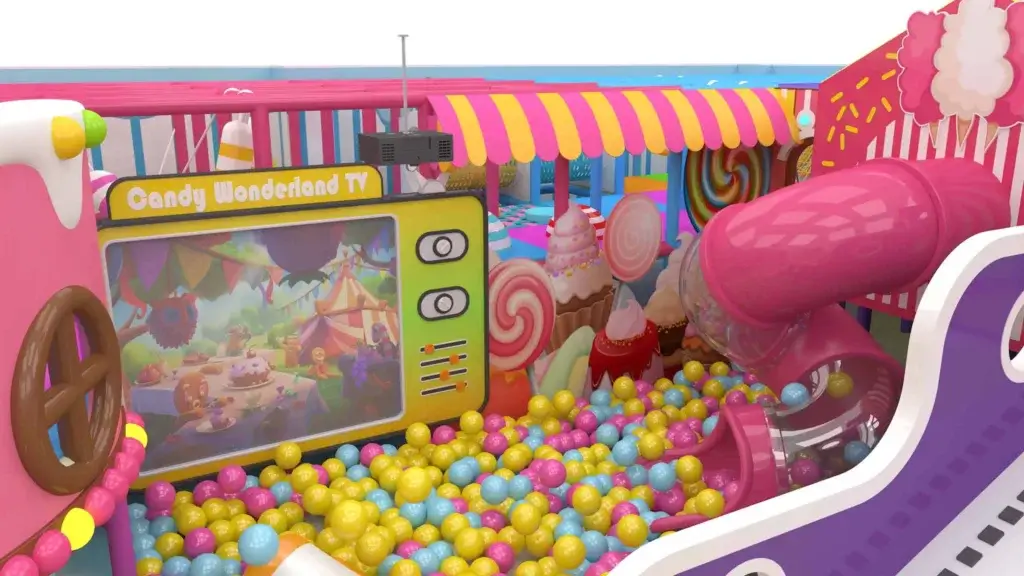Creating a successful indoor playground transcends the mere installation of slides and ball pits. It is about crafting an environment that stimulates a child’s holistic development, ensures their safety, and provides a positive experience for all participants, including caregivers. This professional indoor playground design guide is a detailed expansion of the core strategies for achieving this goal.
1. Create Themed Zones: Structuring a Play Ecosystem
An open, undifferentiated space can be overwhelming and lead to monotonous play. The professional approach is to construct a “play ecosystem” through zoning. This guides children through different types of play experiences, helps manage their energy levels and emotions, and caters to diverse personalities and needs.
- Active Physical Zone: This area is designed for burning energy and developing gross motor skills. It should feature structures that offer a moderate challenge, such as custom obstacle courses (incorporating soft-climb walls, balance beams, and crawl tunnels), mini rock-climbing walls, and trampolines. The flooring must be made of high-impact-absorbing materials like EPDM rubber tiles or seamless foam flooring.
- Imaginative & Role-Play Zone: This is the heart of social and cognitive development. Design micro-environments that mimic real-world scenarios, such as a mini-supermarket, a play kitchen, a doctor’s clinic, or a princess castle. Provide realistic and safe props (e.g., wooden or high-quality plastic food, dolls, costumes) to encourage narrative play, teaching children about turn-taking, sharing, and cooperation.
- Sensory & Calm Zone: Not every child requires high-intensity activity at all times. A designated, softly lit quiet corner is essential for activities like reading, puzzles, or sensory table play (e.g., sand/water tables, treasure bins). This area serves as a “retreat” for introverted, easily overstimulated, or tired children, helping them develop focus and self-regulation skills.
- Professional Implementation: The key to effective zoning lies in visual cues. Employ distinct color schemes, thematic murals, and lighting for each area. For instance, the active zone might use vibrant blues and greens with a space theme, while the imaginative zone could feature warm pinks and yellows in a fairy-tale cottage style. This visual differentiation intuitively guides children and parents.
2. Maximize Vertical Space: Expanding into the Third Dimension
While floor space is finite, vertical space is an often-untapped resource. Leveraging height not only dramatically increases the playable area but also provides unique sensory experiences and physical challenges.
- Suspended Structures: Where ceiling infrastructure permits, install swings, cargo nets, monkey bars, and suspended bridges. These elements are excellent for developing core strength, balance, and the vestibular system. They act as aerial pathways connecting different platforms.
- Multi-Level Structures & Platforms: Introduce mezzanines, treehouse platforms, or forts to create “upstairs” spaces. This not only physically adds square footage but also gives children a sense of exploration and discovery. These platforms are ideal launch points for slides, fireman’s poles, or vertical net climbers.
- Vertical Slides: Unlike traditional curved slides, vertical drops provide a thrilling element of speed and excitement. They are one of the most space-efficient features and often become the playground’s centerpiece. Safety is paramount: the slide exit must have a sufficient run-off area with cushioned flooring.
- Professional Implementation: Vertical design must prioritize safety. All elevated platforms require adequately high, closely spaced guardrails (typically over 1.1 meters high with gaps less than 9 cm). Furthermore, the design must ensure clear sightlines for caregivers to supervise children on upper levels from the ground.
3. Add Interactive & Creative Elements: Activating Every Surface
Walls and floors should not be passive backgrounds; they can be active participants in play.
- Interactive Walls & Murals: Transform blank walls into engaging activity centers. Examples include a mechanical-themed wall with gears, maze tracks, and spinning valves; or a “quiet wall” with sensory panels featuring Velcro, zippers, buttons, and laces. These are particularly beneficial for toddler sensory development.
- Activity Panels: Scatter activity panels throughout the playground’s circulation paths. These can include shape-sorters, wire bead mazes, spinning gears, and auditory elements like talking tubes. They encourage hands-on learning, fostering problem-solving skills, hand-eye coordination, and logical thinking through play.
- Floor Game Markings: Incorporate durable vinyl decals or painted markings directly onto the floor finish, such as hopscotch, Twister spots, imitation race tracks, or alphabet labyrinths. These low-cost additions spark impromptu group play and can aid in teaching young children colors, numbers, and letters.
4. Ensure Safety and Accessibility: The Foundation of Fun
Safety is the non-negotiable foundation of all design. An unsafe playground fails, no matter how fun it seems. Concurrently, inclusive design ensures every child can participate.
- Material & Structural Safety: All materials must comply with children’s product safety standards, being non-toxic, flame-retardant, and easy to clean. All structural edges and corners must be rounded. Flooring should universally consist of impact-absorbing materials like closed-cell foam mats, rubber tiles, or seamless PU flooring, with a Critical Fall Height (HIC) rating that meets or exceeds local safety regulations.
- Accessibility by Design: Adhere to universal design principles to ensure children using wheelchairs can enjoy most of the facilities. This includes sufficiently wide pathways, ground-level playhouses, accessible sensory panels, and, where possible, ramps or platform lifts to access main structures.
- Design for Caregivers: A comfortable caregiver area is not a luxury but a necessity. Provide ample, well-positioned seating (preferably upholstered benches or armchairs) that offers unobstructed sightlines across the play area. Including power outlets, free Wi-Fi, and small tables significantly enhances the caregiver experience, encouraging longer visits. A relaxed caregiver is more likely to allow their child the freedom to play fully and immersively.
5. Foster Imagination and Creativity: Giving the Playground a Soul
A playground that sparks imagination will create lasting memories and ensure repeat visits.
- Themed Play Scenarios: Select an captivating, broad theme such as a tropical rainforest, deep-sea exploration, medieval castle, or astronaut training center. Use high-quality sculptures, murals, lighting, and sound effects to create an immersive atmosphere. Crucially, thematic elements should be integrated into playable components—for example, a dinosaur skeleton that is also a climbable structure.
- Flexible & Updateable Decor: Children’s interests evolve rapidly. Utilizing removable wall decals, interchangeable backdrop panels, and modular props allows for periodic refreshes of the playground’s aesthetic and narrative without major renovations, maintaining a sense of novelty.
- Multi-Functional Furniture & Props: Choose open-ended play materials. For instance, a set of large foam blocks can be built into a castle, a ship, or a robot. These “non-prescriptive” toys are unparalleled in stimulating creativity, as their use is defined solely by the child’s imagination and can evolve as the child grows.
6. FAQ Guide for Indoor Playground Suppliers
Whether you are a procurement officer, company buyer, playground distributor, or individual investor, this guide will help you understand how a top-quality, customizable indoor playground supplier can meet your specific needs.
What Are The Safety Standards For Your Indoor Playground Equipment?
Your safety is our top priority. Our indoor playground equipment complies with international safety standards, including ASTM, CE, ISO, and TUV. We use non-toxic, environmentally friendly materials that undergo rigorous testing before leaving the factory to ensure your playground is safe and reliable.Can You Customize The Playground Design According To Our Specific Requirements?
Yes, we can. Our design team specializes in creating customized playgrounds tailored to your specific needs and preferences. We work closely with you to develop innovative and attractive designs that fit your space and budget, ensuring your vision comes to life.What Is The Typical Lead Time For Designing And Manufacturing Indoor Playground Equipment?
The design phase generally takes about 1-2 weeks, depending on the complexity of the project. Once the design is approved, manufacturing and delivery typically take 4-6 weeks. We strive to deliver your customized playground as quickly and efficiently as possible.How Do You Ensure The Durability And Quality Of Your Products?
We use high-quality materials and advanced manufacturing techniques to ensure the durability and quality of our products. Each product undergoes stringent quality control checks throughout the production process, ensuring you receive equipment that is built to last.What Kind Of Maintenance Is Required For Indoor Playground Equipment?
Our indoor playground equipment requires minimal maintenance. Regular cleaning and periodic inspections for wear and tear are recommended to keep your playground in top condition. We provide detailed maintenance guidelines and support to help you maintain your equipment.Do You Provide Installation Services?
Yes, we do. We offer professional installation services to ensure your playground is set up correctly and safely. Our experienced installation team will handle the entire process, giving you peace of mind and saving you time and effort.Can You Help Us With The Design Layout And Planning Of The Playground?
Absolutely. Our design team will assist you with layout planning and design to maximize the use of your space. We aim to create an engaging and safe playground environment that meets your specific requirements and optimizes the play experience.What Is The Warranty On Your Indoor Playground Equipment?
We offer a comprehensive warranty on all our indoor playground equipment. The warranty covers manufacturing defects and material quality, with specific terms varying by product. You can rely on us for support and service throughout the lifespan of your equipment.What Types Of Indoor Playground Equipment Do You Offer?
We offer a wide range of indoor playground equipment, including adventure parks, trampoline parks, inflatable parks, and soft play equipment. Our product range covers 24 series with thousands of attractive designs, ensuring you find the perfect fit for your needs.How Can We Place An Order Or Get A Quote?
Placing an order or requesting a quote is easy. Contact us via email at dc02@dc-play.com or through our website. Our sales team will respond promptly to discuss your requirements and provide a detailed quotation, ensuring a smooth and efficient process.
By addressing these common questions, we hope to provide you with the information you need to make an informed decision. If you have any additional questions or require further assistance, please feel free to contact Guangdong Dream Catch Recreation Equipment Co., Ltd. We are here to help you every step of the way.





